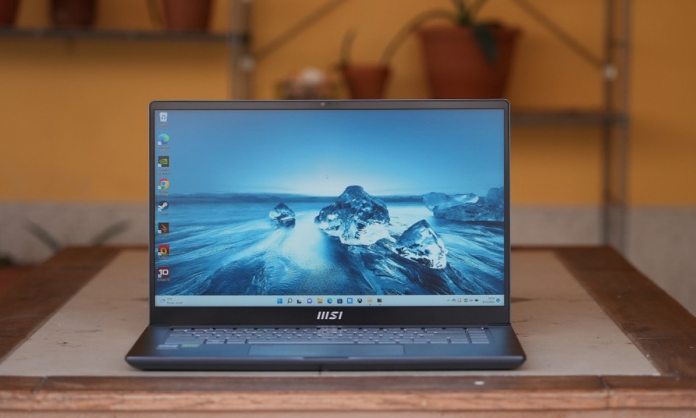The new MSI Prestige 15 is what we could call an “everyday notebook” and also for almost all users. In fact, it can easily support the multitasking of a standard daily use without overheating and without becoming excessively noisy and, depending on the configuration chosen, it can also help you perform tasks even more demanding than the simple daily work routine. Thanks to the dedicated GPU we can also push towards a bit of multimedia and, why not, even a little bit of light gaming.
I have been using this notebook for a few days and I am therefore ready to tell you my impressions and thoughts. I will do it in the lines below, also taking into account the differences, actually few, compared to the previous model, which is no longer easy to find but which can certainly be an interesting alternative.
Seen in this way, at first glance, the new MSI Prestige 15 appears exactly for what it is: a classic notebook with a 15.6-inch diagonal display in 16: 9 format. The dimensions are those typical of a product in this category, with a weight of 1.7 kg in the configuration at our disposal and a sober design. Sober but still distinguishable thanks to the matt gray-blue color that gives it a certain character. Being a notebook not directly intended for gaming users, I also appreciated the manufacturer’s choice to use the most modern and clean version of the logo compared to the usual dragon.
They seem small but these details, combined for example with the font used for the letters of the keyboard, which is different and cleaner than that used in gaming notebooks, are the testimony of the care that MSI is investing in the creation of products that deviate from what has been its core business until now.
The body is then made entirely of aluminum and conveys a feeling of good solidity. Keyboard and palm rest do not flex, unless you go to press very hard, but it is something that will never happen to you. Here perhaps you could reinforce a little the panel behind the display that, despite being also in metal alloy is not really rigid, indeed. The good news comes instead from the hinges, sufficiently solid and able to rotate the display 180 degrees by lying it completely on the support surface.
Good keyboard, which convinced me from the point of view of ergonomics thanks to standard size keys well spaced between them and characterized by a fairly deep stroke, a feature that redeems at least in part the absence of a clear and precise click. The layout is the classic one of a 15-inch notebook without a numeric keypad and, in general, we are faced with a solution that needs little time to familiarize and start typing with ease.
Sufficient touchpad. The dimensions are not huge, we are far from the surface available for the touchpad of a MacBook Pro, but I was absolutely impressed by its finish. We are talking about a frosted glass surface that offers an almost soft sensation to the touch; It is not new, it was the same for the previous model but good that it has not changed. In the upper left corner of this touchpad we then find a fingerprint reader for secure access to Windows that does its job well on all occasions. In reality there is a defect and it is given by the excessive flexibility of the plastic that makes up the touchpad, very yielding in correspondence of the right and left buttons.
I would then like to say a few words about the availability of expansion ports. Putting together both sides of the body we therefore have two USB Type C with Thunderbolt support (both usable to charge the notebook), an HDMI in standard format, a combo jack for microphone and headphones and two USB type A. There is also a memory card slot, unfortunately only micro SD, but still absolutely better than nothing.
Well, I told you for a moment about what is outside, but I would not waste too much time because the most interesting things of this Prestige 15 are probably hidden under the body. The engine of this notebook is in fact an Intel Core i7 1280P flanked by a discrete GPU NVIDIA GeForce RTX 3050 in its configuration with TDP from 35-40W. In addition to these components we then find 16 GB of LDPPR4x RAM, unfortunately MSI has not updated it and has remained the same as the previous model, in addition to a 1 TB PCIe 4.0 SSD produced by Samsung. It is a very fast drive, we are talking about 6500 MB / s reading and almost 5000 writing, which can be flanked by an additional disk in the same format thanks to a second slot on the motherboard and easily accessible by removing the rear panel. Unlike the disk, the RAM is instead soldered and therefore not expandable.
As you surely know by now, the Core i7 1280P is equipped with 14 total cores of which 6 performance cores (max 4.8GHz) and 8 efficency cores (max 3.6GHz). We then conducted our usual stress tests to analyze the behavior of the CPU and subsequently also of the GPU under maximum stress conditions. They are, as always, extreme scenarios, which you will hardly encounter in everyday use, but let’s say that good behavior in these tests is, inevitably, synonymous with good performance even in daily use. Before starting with the tests we also activated the maximum performance profile in the MSI Center app; with this operation PL1 and PL2 are set to 45W and 64W respectively.
Let’s start as always from the stress test that predicts a 100% load on all CPU cores. The behavior we see in the graph above is quite typical. The P-Cores work at an average of 2.5 GHz, while the E-Cores are positioned a little below with a clock frequency that stands at around 2.1 GHz. These values are quite lower than the maximum achievable by the different cores, but when all the cores are involved, the system is subjected to a considerable effort, the temperatures rise and to avoid obvious throttling problems the frequencies are cut. In detail here we have an average temperature on the CPU of 93 degrees and a TDP that remains practically for the duration of the test at 50W.
The good news is that even in these conditions the notebook remains responsive and you can continue to work; So there’s a bit of throttling but it’s not overly penalizing. Obviously during this type of test the fans are activated and are felt; The rustle is also noticeable a few meters away but nothing that can not be silenced with a pair of headphones. In terms of temperatures on the body, however, they reach 37 degrees at the top of the keyboard that become 40 on the back where we have the hot air vent.
Well, so we added the GPU to the equation, which is also 100% loaded, and what you see above are the results. Obviously, the frequencies of the CPU cores drop a little, up to 1.9 GHz for P-Cores and 1.5 for E-Cores. Temperatures travel around 90 degrees, while the TDP drops considerably to an average of about 30W. The other 30W are in fact taken from the GPU that in this situation runs at an average frequency of about 1 GHz. As for the temperatures on the body and the noise, the situation remains identical to what has been said above.
In general, therefore, we are talking about a product that is able to guarantee solid performance in all those that are the most common operations. In everyday use this notebook is a splinter and often runs at much lower frequencies than seen above, with a consumption that is generally still around 5-6W. In these situations there are no throttling episodes and, even when engaged in the most demanding tasks, it always remains stable. On the surface the body heats up a lot only in the upper part near the display; Not bad, we will hardly go to get our hands in that point.
Thanks to the dedicated GPU we can also occasionally venture a gaming use. Newer games are fairly supported; Obviously if you want a framerate that is constantly above 60 fps the advice is to play in 1080p and with a medium-low level of detail.
Also noteworthy is the presence of Bluetooth, in version 5.0, which works well with all the accessories with which I tried it (OnePlus Bullets headphones, Logitech MX Master mouse, Razer Raiju joypad), and the latest generation WiFi ax modem.















